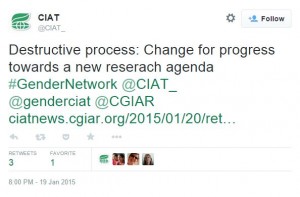 In January I was working with the CGIAR Gender in Agricultural Research Network during their meeting. My wonderful client, Jacqui Ashby trusted me to use many of the Liberating Structures with the group. We used the Ecocycle Planning structure early on to help think about the network member’s work in a slightly different ways.
In January I was working with the CGIAR Gender in Agricultural Research Network during their meeting. My wonderful client, Jacqui Ashby trusted me to use many of the Liberating Structures with the group. We used the Ecocycle Planning structure early on to help think about the network member’s work in a slightly different ways.
This is the third time I’ve used the Ecocycle Planning “full on,” in other words, I hung a meaningful part of an agenda on to it. I am getting more confident in how I launch the process and appreciate the value of practicing and observing others (like Keith McCandless) running the process and learning from them.
 Simone Staiger, of CIAT, wrote about the experience on her Knowledge Management blog during the meeting. The tweet was apparently provocative. A few days after Simone tweeted the blog link, she received the most retweets and links than any other post she has tweeted out. Is it the phrase “destructive process” that caught people’s eyes and imaginations?
Simone Staiger, of CIAT, wrote about the experience on her Knowledge Management blog during the meeting. The tweet was apparently provocative. A few days after Simone tweeted the blog link, she received the most retweets and links than any other post she has tweeted out. Is it the phrase “destructive process” that caught people’s eyes and imaginations?
As it turns out, the conversations around the creative destruction phase of the ecocyle were very interesting to me, and it appears that they were of interest to the participants. Here are the combined notes Simone and I wrote up:
Participants struggled a bit with “Creative destruction.” At first, there was some reluctance to place things in the “creative destruction” area, thinking that this was a negative activity. After some discussion, many groups identified this as a rich area of potential and possibility, the space of innovation and renewal. One participant gave as an example the need to deploy our listening skills to some of their diverse co-workers in order to be able to change mindsets and create and work together. It was also mentioned that it is important that we involve a larger group of “next users” and partners in the creative destruction and renewal phase. This increases the chances for them to support the birth and implementation of ideas and activities.
Are we both excited and afraid of destruction? Is that the power of this area?
Conversations about the Poverty Traps (now renamed Scarcity Trap) and Rigidity Traps are always useful. It’s like we put a name on something familiar, but often unspoken. Being able to frame and discuss these issues is critical.
The other area that held some useful insights was the area of maturity. Not so surprisingly, what one categorizes as a “mature” practice can vary wildly between individuals depending on their experience, what activities they prioritize in their work and other contextual factors. What is often enlightening is the realization that there may not be a shared understanding of those mature practices and therefore a high potential for misalignment.
From a facilitation standpoint, I was worried that the groupings we created for the maps would not work. We had to group people working on different projects together, and in the past, I’d seen better results when an intact team or group maps their project. But I was surprised how much cross project relevance and resonance emerged. I’m not sure we really mined that as much as we might have. There was more to harvest and we left it on the table! Going forward I need to think more deeply about this opportunity. Resonance and dissonance are always rich spaces.